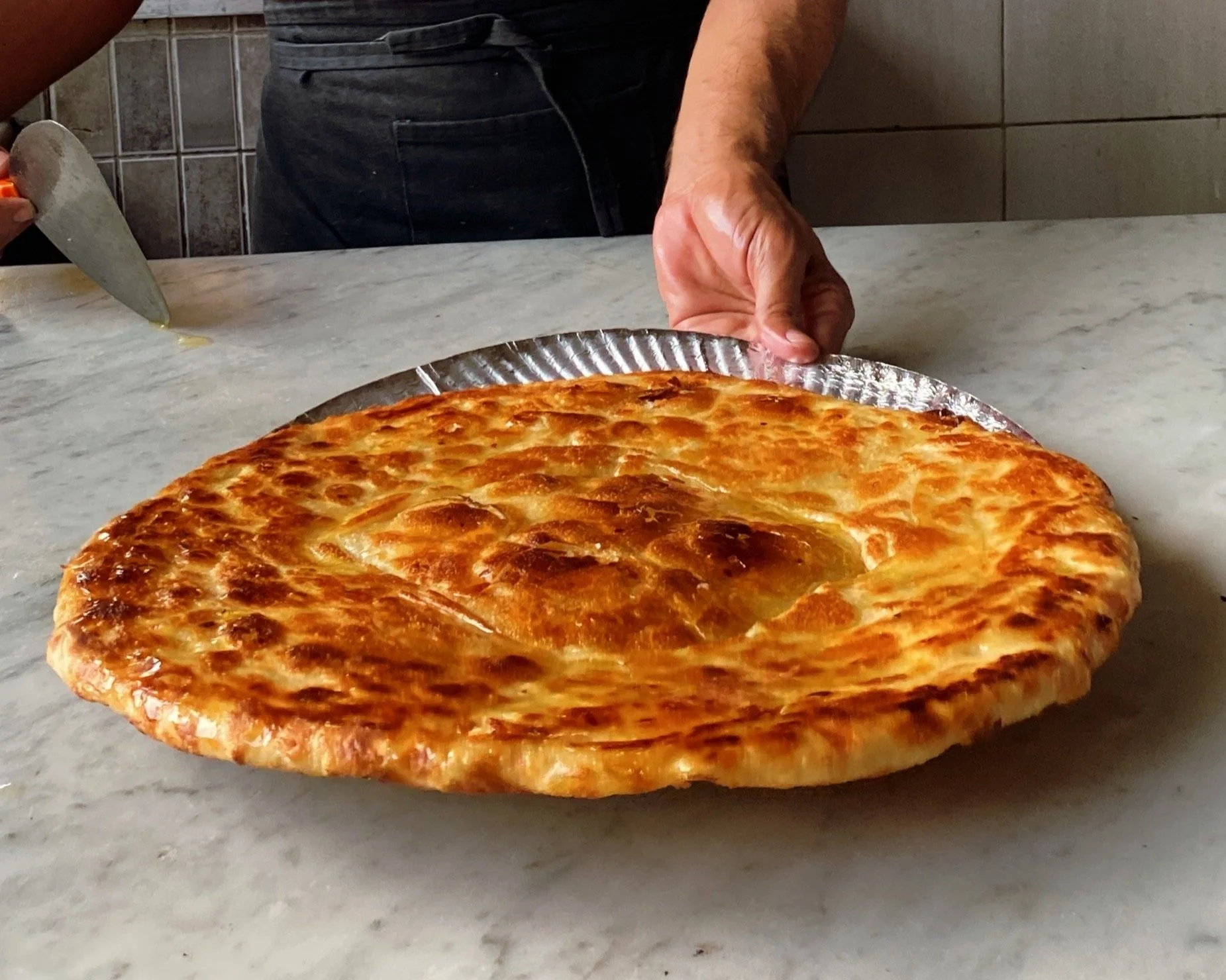Om Ali: The Mystical Dessert with a Controversial History
The idiom "we live to eat, not eat to live" is not unfamiliar in Egypt. When visiting any museum in Egypt, it is evident that the Egyptians' passion and admiration for food is a recurring motif.
You witness murals with lavishly designed dinners and buffets to enjoy with family and friends and to commemorate big events and festivals. It's clear that a basic dessert having controversial origins isn't far-fetched.
Om Ali, which translates as Ali's Mother, has no documented recipe. It was made with ingredients found in the kitchen. Flat Egyptian pastries like Feteer or Rokak were mixed with milk, cream, or condensed milk, and topped with available nuts. It is traditionally served piping hot. Modern versions can use Puff pastry or Phyllo dough instead.
Plain Egyptian Feteer fresh out of the oven
Even though there are no historical references to the actual origin of Om Ali, these are generally held tales found in cultural conversations and culinary anecdotes that agree on the main plot lines but not some of the details. The stories have two things in common: women heroines and Om Ali.
The first stop tells the tale of Shajar Al Durr during the beginning of the Mamluk Dynasty. The Mamluk Dynasty was an Islamic medieval dynasty that ruled from the 13th to the 16th centuries. Originally Asian slave soldiers, the Mamluks rose to power in the Islamic world and established a dynasty with a strong presence in Egypt and parts of the Middle East.
The Mamluk Sultanate region of control.
Source
The Mamluks rose to prominence in Egypt during the Ayyubid period. In 1250, Mamluk commanders, led by Ezz El Din Aybak under Shajar Al Durr, took control and formed the Mamluk Sultanate. This ended the Ayyubid rule.
Shajar Al Durr being serviced by the palace staff
Source
Shajar Al Durr whose name translates to the trees of pearls, was the only woman to rule Egypt alone during the Islamic period, and it was Shajar Al Durr, not Cleopatra, who was the last woman to reign on the Egyptian throne.
After Sultan Salih Ayyub died, the kingdom was under siege by the Crusaders, so Shajar Al Durr covered the Sultan's death, declared him critically ill, and took over as de facto ruler, crushing the Crusaders with an iron fist.
“It was Shajar Al Durr, not Cleopatra, who was the last woman to reign on the Egyptian throne.”
Shajar Al Durr wanted to stay in power but faced resistance and threats of a revolt due to being a woman ruler in an Islamic Dynasty, after eighty days of her reign, she was forced to marry Ezz El Din Aybak, a commander in the Mamluk’s Elite Military under the one condition of divorcing his first wife.
Aybak was the figurehead of the new Mamluk dynasty yet the true authority remained with Shajar Al Durr. He grew tired of the minor role he played and tried to extend his reach as a ruler by taking a new bride, the princess of Mosul. Shajar Al Durr found out his plot and arranged his assassination to remain in power, but there is no solid proof that she ordered his murder.
After Aybak was assassinated, Shajar Al Durr lost her supporters. Al Mansur Ali, Aybak’s first wife's son, then took power with the aid of the Mamluks, who had turned against Shajar Al Durr.
Gustave Dore’s interpretation of Shajar Al Durr ascension to power.
Ali delivered Shajar Al Durr to his mother to decide her fate. Om Ali, Aybak’s widow and first wife, planned her revenge. She had her maids beat Shajar al Durr to death with wooden shoes “Qub Qabs”. Shajar al-Durr was later buried in a tomb, not far from the Mosque of Tulun, which is a testament to Islamic funerary architecture.
WOODEN QUB QABS
Om Ali also ordered a special pudding to celebrate justice served. She came up with the dessert, later named Om Ali by mixing Feteer or Rokak, common daily items available to poor people with the not-so-common ingredients of milk, sugar, and nuts which were expensive. The dessert represents justice and concludes a tale of revenge and retribution and is enjoyed by rich and poor people alike.
Shajar Al Durr’s resting place
Another tale is based on folklore. Om Ali is believed to have once been a commoner celebrated for her charity. When a Sultan came to her town, she wanted to make something special for him. She prepared this dish with the ingredients she had on hand and shared it with neighbours. The Sultan was so taken with it that he requested the recipe and had it produced by the royal cooks, making it famous as a royal treat.
Om Ali in Egyptian traditional clay pot
We are reminded that culinary traditions can spin complex tales of strength, resiliency, and the enduring bond between food and culture as we savor the layers of Om Ali's odd past. This dessert captures the essence of Egypt's culinary and historical legacy. It's creamy and rich, with echoes of the past in every bite.
Would you like to get your hands on our recommendations for where to try Om Ali during your visit to Cairo? Or better yet, join our class to learn how to make Om Ali yourself!
Enjoy 10% off with promo code : COOKOMALI







